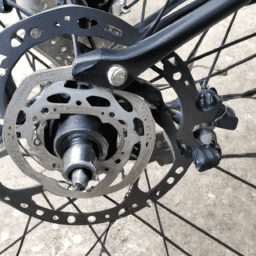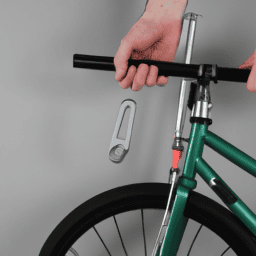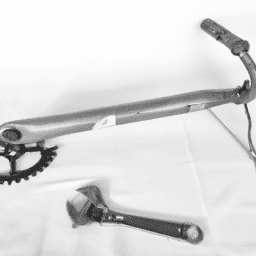I’ve been passionate about cycling for many years, and a key insight I’ve gained is the critical role of well-maintained brakes. No matter if you ride occasionally or are an experienced professional, the ability to fine-tune your brakes is an essential skill all cyclists must possess.
In this article, I’ll be sharing my step-by-step guide on how to adjust your brakes on a bicycle.
First, it’s essential to understand the basics of how your bicycle brakes work. There are two main types of brakes: rim brakes and disc brakes. Rim brakes use brake pads to grip the sides of the wheel’s rim, while disc brakes use calipers to squeeze a rotor attached to the wheel hub.
Regardless of the type of brake you have, the process of adjusting them is relatively similar. By following these steps, you’ll be able to ensure that your brakes are working correctly and safely.
Key Takeaways
- Properly functioning brakes are crucial for cyclist safety, and regular maintenance is necessary.
- There are two main types of brakes for bicycles: rim brakes and disc brakes.
- Checking brake components for wear and tear and positioning/tightening brake pads is essential for optimal stopping power.
- Adjusting brake tension, lever position, and testing brakes on flat surfaces and hills are all essential steps for safe and enjoyable cycling.
Understand the Basics of Bicycle Brakes
If you’re going to adjust your brakes, it’s important to first understand the basics of how bicycle brakes work.
There are two main types of brake systems: rim brakes and disc brakes.
Rim brakes use rubber brake pads that grip the rim of the wheel to slow it down, while disc brakes use a metal rotor and caliper that clamp down on the rotor to slow the wheel.
Disc brakes have several advantages over rim brakes, including better stopping power, greater control, and improved performance in wet or muddy conditions.
They are also less affected by rim wear and tear, which can cause rim brakes to lose effectiveness over time.
However, disc brakes can be more expensive to maintain and repair, and may require special tools and expertise to adjust properly.
As you understand the basics of bicycle brakes, the next step is to check your brakes for wear and tear.
Check Your Brakes for Wear and Tear
First, take a close look at your brake pads and note any signs of wear and tear, like cracks or thinning. Think of the brake pads like the soles of your shoes – they need to be in good condition to provide the necessary grip and traction.
Inspecting brake components is an essential part of maintaining your bicycle’s safety. If the brake pads are worn down or damaged, they won’t be able to grip the rim or rotor effectively, which can lead to accidents.
To replace worn brake pads, follow these steps:
- Loosen the brake pad retention bolt with an Allen wrench.
- Slide the old brake pad out of the holder and insert the new one.
- Tighten the retention bolt to secure the new brake pad in place.
By checking and replacing worn brake pads, you can ensure that your bike’s brakes are functioning optimally.
Now, let’s move on to adjusting your brake pads for even better performance.
Adjust Your Brake Pads
Now that your brake pads are in good condition, it’s time to make sure they’re aligned correctly for optimal stopping power. Proper brake alignment is crucial in ensuring that your brakes are functioning at their best.
To adjust your brake pads, first loosen the bolt that holds the brake pad in place. Then, position the brake pad so that it’s hitting the rim of the wheel directly in the center. Tighten the bolt again and check to ensure that the pad is hitting the rim evenly on both sides. Repeat this step for the other brake pad.
If you find that your brake pads are too worn down to adjust properly, it may be time for brake pad replacement. This is a relatively simple process that involves removing the old brake pads and inserting new ones. Make sure to choose brake pads that are compatible with your bike’s braking system and follow the manufacturer’s instructions for installation.
With properly aligned brake pads or new ones installed, you can move on to the next step of testing your brakes to ensure they’re in good working order.
Test Your Brakes
Now that I’ve adjusted my brake pads, it’s important to test my brakes to ensure they’re functioning properly.
First, I’ll adjust the brake lever position to make sure it’s comfortable and easy to reach.
Next, I’ll test the brakes on a flat surface to ensure they stop the bike smoothly and evenly.
Finally, I’ll test the brakes on a hill to make sure they can handle stopping the bike when going downhill.
It’s crucial to test the brakes thoroughly before riding to prevent any accidents or mishaps.
Adjust Brake Lever Position
Properly positioning brake levers is paramount for precise braking performance on your bike. There are different types of brake levers, including drop bar levers and flat bar levers, so it’s important to understand how to install them correctly. Here are three key steps to adjust the brake lever position on your bike:
-
Determine the most comfortable position for your hands. This will depend on the type of riding you do and your personal preferences. However, a good rule of thumb is to position the brake lever so that it is easily accessible without having to move your hand from the handlebar.
-
Install the brake lever on the handlebar. Make sure the lever is aligned with the brake cable and tightened securely. Test the lever by squeezing it to make sure it engages the brake.
-
Adjust the position of the lever as needed. If the lever is too high or too low, it can affect your ability to brake effectively. Use an Allen wrench to adjust the position of the lever until it’s in the most comfortable and accessible position for you.
Now that you’ve adjusted the brake lever position, it’s time to test the brakes on a flat surface. This’ll ensure that your brakes are working properly and that you can stop safely when riding your bike.
Test the Brakes on a Flat Surface
Once you’ve positioned the brake lever to your liking, it’s time to give the brakes a test run on a flat surface. This is an important step in adjusting your brakes because it allows you to gauge their responsiveness.
To do this, find a flat surface with plenty of room to ride. Begin by slowly pedaling on the flat surface and gently squeezing the brake lever. You should feel an immediate response from the brakes.
If the brakes are not responsive or feel loose, you may need to adjust the tension on the brake cables. Once you’ve tested the brakes on the flat surface and are satisfied with their responsiveness, you can move on to testing the brakes on a hill.
Testing the brakes on a hill will give you a better idea of their stopping power. It’s important to note that you should only test the brakes on a hill that you feel comfortable riding down. If the brakes do not respond as well as they did on the flat surface, you may need to make further adjustments.
With proper brake adjustment, you can ensure that your bicycle stops when you need it to, keeping you safe on the road.
Test the Brakes on a Hill
When testing your brakes on a hill, you’ll want to make sure that you’re on a slope that you feel comfortable riding down, so you can get a sense of their stopping power. Hill testing is crucial to ensure that your brakes will perform effectively in real-world scenarios. Here are some tips to help you test the performance of your brakes on a hill:
-
Start by riding down the hill at a slow speed, and apply the brakes lightly to get a feel for their responsiveness.
-
Gradually increase your speed on subsequent runs and apply the brakes more firmly to see how well they slow you down.
-
Practice stopping quickly on the hill to simulate emergency stops and assess the brake performance in such situations.
It’s important to remember that brake performance can vary based on factors such as the weather, terrain, and the condition of your bike.
After hill testing, it’s time to fine-tune your brakes to ensure that they’re working optimally.
Fine-Tune Your Brakes
To really get your brakes working optimally, it’s essential that you fine-tune them regularly. This will not only improve your braking power but also reduce brake squeaking.
First, check the brake pads for wear and ensure they’re properly aligned with the rim. You should also adjust the cable tension so that the pads are at the right distance from the rim when the brakes are applied.
Next, make sure the brake pads are clean and free of debris. You can use a small amount of rubbing alcohol to clean them. Additionally, check the rim for any dents or damage that may be affecting the braking performance.
Finally, test the brakes again to ensure they’re working as expected. Fine-tuning your brakes may seem like a minor task, but it can make a significant difference in your overall bike safety and performance.
Adjusting your bike brakes is an essential task that can significantly reduce the risk of accidents while cycling. By understanding the process of fine-tuning your brakes, you can ensure that your brakes are working optimally, improving your braking power and reducing brake squeaking.
So, make sure to regularly check and adjust your brakes to ensure a safe and enjoyable ride.
Frequently Asked Questions
What tools and equipment are needed to adjust bicycle brakes?
To adjust bicycle brakes, I need a wrench, pliers, and a cable cutter. Brake adjustment techniques vary depending on the type of brakes and different types of brake cables require different adjustments.
How often should bicycle brakes be adjusted?
I typically perform frequency adjustments and brake maintenance every 3-6 months, depending on how frequently I ride my bike. This ensures that my brakes are consistently working properly and I can avoid any potential safety hazards.
What are the common causes of squeaky brakes and how can they be fixed?
My heart sinks as the shrill sound pierces the air. Squeaky brakes are the bane of a cyclist’s existence. Common causes include worn brake pads or dirty rims. Regular cleaning and pad replacement can maintain brake performance.
How can I improve the stopping power of my brakes?
To improve braking power, regular brake maintenance is crucial. Start by inspecting brake pads and rotors for wear and debris. Adjust brake calipers and replace worn parts as needed. Properly aligned brakes and clean components will ensure optimal stopping performance.
Can I adjust the tension of my brake cables and if so, how?
My brake tension can be adjusted by turning the barrel adjuster on the brake lever. However, if I’m unsure or the issue persists, seeking professional help is recommended to ensure safety. It’s like tinkering with a delicate machine.
Conclusion
So there you have it, folks! Adjusting the brakes on your bicycle is an essential skill that every cyclist should learn.
It may seem daunting at first, but with practice and patience, you can master the art of fine-tuning your brakes.
Remember, your brakes are your lifeline when you’re out on the road or trail. They stop you from crashing into obstacles, help you slow down on steep descents, and give you the confidence to take on challenging terrain.
So, take the time to understand the basics of bicycle brakes, check your brakes for wear and tear, adjust your brake pads, test your brakes, and fine-tune them to perfection.
Your bike (and your safety) will thank you for it!









